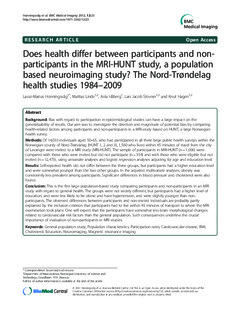| dc.contributor.author | Honningsvåg, Lasse-Marius | |
| dc.contributor.author | Linde, Mattias | |
| dc.contributor.author | Håberg, Asta | |
| dc.contributor.author | Stovner, Lars Jacob | |
| dc.contributor.author | Hagen, Knut | |
| dc.date.accessioned | 2019-10-15T07:28:25Z | |
| dc.date.available | 2019-10-15T07:28:25Z | |
| dc.date.created | 2012-08-22T18:16:28Z | |
| dc.date.issued | 2012 | |
| dc.identifier.issn | 1471-2342 | |
| dc.identifier.uri | http://hdl.handle.net/11250/2622132 | |
| dc.description.abstract | Background
Bias with regard to participation in epidemiological studies can have a large impact on the generalizability of results. Our aim was to investigate the direction and magnitude of potential bias by comparing health-related factors among participants and non-participants in a MRI-study based on HUNT, a large Norwegian health survey.
Methods
Of 14,033 individuals aged 50–65, who had participated in all three large public health surveys within the Norwegian county of Nord-Trøndelag (HUNT 1, 2 and 3), 1,560 who lived within 45 minutes of travel from the city of Levanger were invited to a MRI study (MRI-HUNT). The sample of participants in MRI-HUNT (n = 1,006) were compared with those who were invited but did not participate (n = 554) and with those who were eligible but not invited (n = 12,473), using univariate analyses and logistic regression analyses adjusting for age and education level.
Results
Self-reported health did not differ between the three groups, but participants had a higher education level and were somewhat younger than the two other groups. In the adjusted multivariate analyses, obesity was consistently less prevalent among participants. Significant differences in blood pressure and cholesterol were also found.
Conclusion
This is the first large population-based study comparing participants and non-participants in an MRI study with regard to general health. The groups were not widely different, but participants had a higher level of education, and were less likely to be obese and have hypertension, and were slightly younger than non-participants. The observed differences between participants and non-invited individuals are probably partly explained by the inclusion criterion that participants had to live within 45 minutes of transport to where the MRI examination took place. One will expect that the participants have somewhat less brain morphological changes related to cardiovascular risk factors than the general population. Such consequences underline the crucial importance of evaluation of non-participants in MRI studies. | nb_NO |
| dc.language.iso | eng | nb_NO |
| dc.publisher | BMC | nb_NO |
| dc.rights | Navngivelse 4.0 Internasjonal | * |
| dc.rights.uri | http://creativecommons.org/licenses/by/4.0/deed.no | * |
| dc.title | Does health differ between participants and non-participants in the MRI-HUNT study, a population based neuroimaging study? The Nord-Trøndelag health studies 1984-2009 | nb_NO |
| dc.type | Journal article | nb_NO |
| dc.type | Peer reviewed | nb_NO |
| dc.description.version | publishedVersion | nb_NO |
| dc.source.volume | 12:23 | nb_NO |
| dc.source.journal | BMC Medical Imaging | nb_NO |
| dc.identifier.doi | 10.1186/1471-2342-12-23 | |
| dc.identifier.cristin | 940303 | |
| dc.description.localcode | © 2012 Honningsvåg et al.; licensee BioMed Central Ltd. This is an Open Access article distributed under the terms of the Creative Commons Attribution License (http://creativecommons.org/licenses/by/2.0), which permits unrestricted use, distribution, and reproduction in any medium, provided the original work is properly cited. | nb_NO |
| cristin.unitcode | 194,65,30,0 | |
| cristin.unitcode | 1920,16,0,0 | |
| cristin.unitname | Institutt for nevromedisin og bevegelsesvitenskap | |
| cristin.unitname | Nevroklinikken | |
| cristin.ispublished | true | |
| cristin.fulltext | original | |
| cristin.qualitycode | 1 | |

